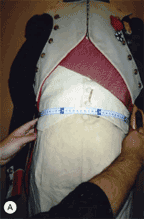JOURNAL CLUB FIND: NAPOLEON’S PANTS

REFERENCE:
Napoleon’s autopsy: New perspectives. (2005) A. Lugli MD, A. Kopp Lugli, M. Horcic. Human Pathology (2005) 36, 320-324
ABSTRACT:
In 1821 Napoleon died in exile on the Island of St. Helena. Although the autopsy had suggested stomach cancer as the cause of death, in 1961 an elevated arsenic concentration was found in Napoleon’s hair. This finding elicited numerous theories of conspiracy, treachery, and poisoning. Most recent reports even suggested inappropriate medical treatment may have contributed to the exiled Emperor’s death.
Napoleon’s apparent obesity at the time of his demise was interpreted as a strong argument against stomach cancer as the cause of death; however, his weight changes over the course of his life, noticeable from the contemporary iconography, have not been systematically analyzed.
To test the hypothesis that Napoleon’s weight at death could be compatible with a diagnosis of terminal gastric cancer, we performed several studies to determine: a) Napoleon’s weight at death; and b) the changes of his weight during the last 20 years of his life. Our weight modeling was based on the collection of 12 different pairs of trousers worn by Napoleon between 1800 and 1821, the year of his death. Modeling trouser sizes with control data suggested a weight increase from 67 kg to 90 kg by 1820. The trousers worn at the time of death suggested a subsequent weight loss of 11 kg (to 79 kg) during the last year of his life. This weight was confirmed by a second modeling approach based on the subcutaneous fat measurement performed at autopsy (1.5 inches) and a control group of 270 men dying from various causes. This provides a reasonable validation for both weight measurement methods.
Napoleon’s terminal weight loss of more than 10 kg is suggestive of a severe progressive chronic illness and is highly consistent with a diagnosis of gastric cancer.
(Copyright 2005 Elsevier Inc. All rights reserved).